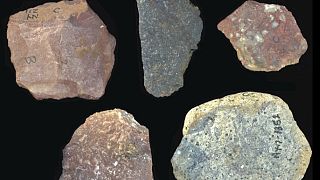Morocco
Archaeologists in Morocco have announced the discovery of North Africa's oldest Stone Age hand-axe manufacturing site, dating back 1.3 million years, an international team reported Wednesday.
The find pushes back by hundreds of thousands of years the start date in North Africa of the Acheulian stone tool industry associated with a key human ancestor, Homo erectus, researchers on the team told journalists in Rabat.
It was made during excavations at a quarry on the outskirts of the country's economic capital Casablanca.
This "major discovery... contributes to enriching the debate on the emergence of the Acheulian in Africa," said Abderrahim Mohib, co-director of the Franco-Moroccan "Prehistory of Casablanca" programme.
Before the find, the presence in Morocco of the Acheulian stone tool industry was thought to date back 700,000 years.
New finds at the Thomas Quarry I site, first made famous in 1969 when a human half mandible was discovered in a cave, mean the Acheulian there is almost twice as old.
The 17-strong team behind the discovery comprised Moroccan, French and Italian researchers, and their finding is based on the study of stone tools extracted from the site.
Moroccan archaeologist Abdelouahed Ben Ncer called the news a "chronological rebound".
He said the beginning of the Acheulian in Morocco is now close to the South and East African start dates of 1.6 million and 1.8 million years ago respectively.
Earlier humans had made do with more primitive pebble tools, known as Oldowan after their East African type site.
Research at the Casablanca site has been carried out for decades, and has "delivered one of the richest Acheulian assemblages in Africa", Mohib said.
"It is very important because we are talking about prehistoric time, a complex period for which little data exists."
Mohib said the study also made it possible to attest to "the oldest presence in Morocco of humans" who were "variants of Homo erectus".
Prehistoric man's ability to "design the shape of the tool he wants", such as the latest find, was a "very important technological advance," he added.
In 2017, the discovery of five fossils at Jebel Irhoud in Morocco, estimated at 300,000 years old, overturned evolutionary science when they were designated Homo sapiens.
The Moroccan fossils were much older than some with similar facial characteristics excavated from Omo Kibish in Ethiopia, dating back around 195,000 years.
The "Prehistory of Casablanca" programme is the result of collaboration between the Moroccan Institute of Archaeology (INSAP), Paul-Valery Montpellier 3 University in Montpellier, France, and the French foreign ministry.
French and Italian laboratories also took part in the project.
The Paleolithic age is the first and longest period of prehistory which began more than three million years ago and ended 12,000 years ago.











Go to video
Exhibition in Morocco explores a world of color
Go to video
The EU moves to fast-track asylum claims by migrants from 7 countries to speed deportation
00:50
Spain: human trafficking ring smuggling moroccans into europe dismantled
Go to video
France and Algeria resume diplomatic talks aimed at mending rift
Go to video
Ghana and Morocco move to scrap visa requirements
Go to video
A restored ancient museum palace showcases treasures from the Islamic world